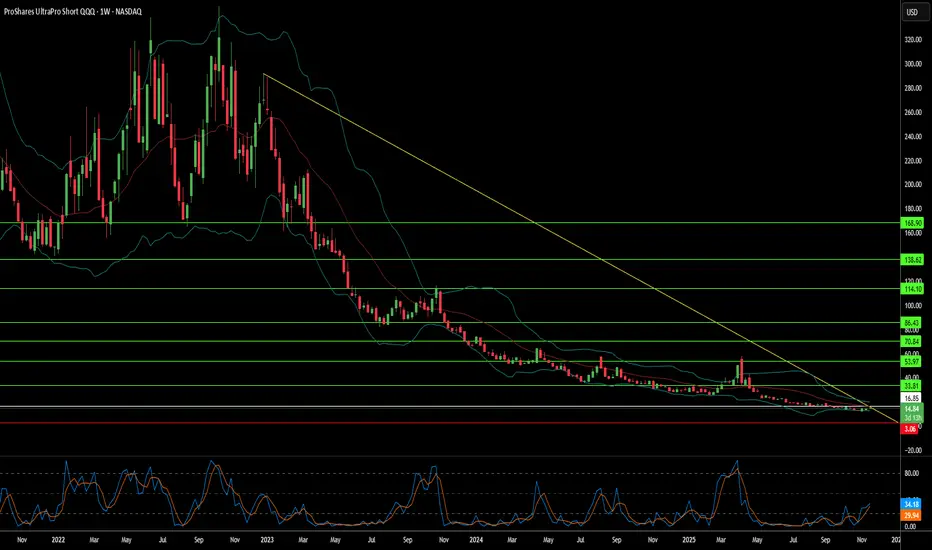How escalating China-Japan geopolitical tensions create a compelling investment case for ProShares UltraPro Short QQQ (SQQQ), a triple-leveraged inverse ETF tracking the Nasdaq-100 Index (NDX). The Nasdaq-100's extreme concentration in technology sectors (61% weighting) and dependence on flawless global supply chains make it uniquely vulnerable to Asia-Pacific instability. SQQQ's triple-inverse structure allows investors to profit from anticipated NDX declines without traditional margin accounts, while its daily compounding mechanism is optimized for capturing the high-volatility, directional downside movements that geopolitical crises typically trigger.
The core vulnerability stems from critical supply chain chokepoints in East Asia. China controls nearly 90% of global rare earth element processing materials essential for EV motors, sensors, and defense systems, and has previously weaponized this dominance against Japan during territorial disputes. Meanwhile, Japan holds a 50% global market share in critical semiconductor materials like photoresists, making any disruption equivalent to halting chip fabrication for NDX companies. With the Nasdaq-100 deriving approximately 10% of revenues directly from Mainland China and nearly 50% internationally, escalating tensions threaten simultaneous revenue losses across multiple major markets while forcing costly supply chain regionalization that compresses profit margins.
Beyond physical supply chains, the analysis identifies state-sponsored cyber operations as the most immediate acute threat. U.S. agencies assess that Chinese cyber actors are pre-positioning themselves on critical infrastructure networks to enable disruptive attacks during major crises, with Japan reporting prior Chinese military cyberattacks against 200 companies and research institutes. Such cyber-induced production halts could generate billions in lost revenue while simultaneously degrading the innovation output that sustains NDX valuations. Geopolitical uncertainty correlates directly with reduced corporate R&D spending and demonstrable declines in patent quality and citation rates.
The convergence of these risks, supply chain weaponization, forced regionalization costs, elevated discount rates from geopolitical risk premiums, and cyber warfare threats creates an optimal environment for SQQQ's triple-inverse exposure. Corporate boards failing to incorporate robust geopolitical risk monitoring into NDX valuations represent a fundamental governance failure, as the structural shift from global efficiency to resilience-focused supply chains necessitates significant capital expenditure that undermines the high-growth valuations supporting current NDX prices.
The core vulnerability stems from critical supply chain chokepoints in East Asia. China controls nearly 90% of global rare earth element processing materials essential for EV motors, sensors, and defense systems, and has previously weaponized this dominance against Japan during territorial disputes. Meanwhile, Japan holds a 50% global market share in critical semiconductor materials like photoresists, making any disruption equivalent to halting chip fabrication for NDX companies. With the Nasdaq-100 deriving approximately 10% of revenues directly from Mainland China and nearly 50% internationally, escalating tensions threaten simultaneous revenue losses across multiple major markets while forcing costly supply chain regionalization that compresses profit margins.
Beyond physical supply chains, the analysis identifies state-sponsored cyber operations as the most immediate acute threat. U.S. agencies assess that Chinese cyber actors are pre-positioning themselves on critical infrastructure networks to enable disruptive attacks during major crises, with Japan reporting prior Chinese military cyberattacks against 200 companies and research institutes. Such cyber-induced production halts could generate billions in lost revenue while simultaneously degrading the innovation output that sustains NDX valuations. Geopolitical uncertainty correlates directly with reduced corporate R&D spending and demonstrable declines in patent quality and citation rates.
The convergence of these risks, supply chain weaponization, forced regionalization costs, elevated discount rates from geopolitical risk premiums, and cyber warfare threats creates an optimal environment for SQQQ's triple-inverse exposure. Corporate boards failing to incorporate robust geopolitical risk monitoring into NDX valuations represent a fundamental governance failure, as the structural shift from global efficiency to resilience-focused supply chains necessitates significant capital expenditure that undermines the high-growth valuations supporting current NDX prices.
Disclaimer
The information and publications are not meant to be, and do not constitute, financial, investment, trading, or other types of advice or recommendations supplied or endorsed by TradingView. Read more in the Terms of Use.
Disclaimer
The information and publications are not meant to be, and do not constitute, financial, investment, trading, or other types of advice or recommendations supplied or endorsed by TradingView. Read more in the Terms of Use.
